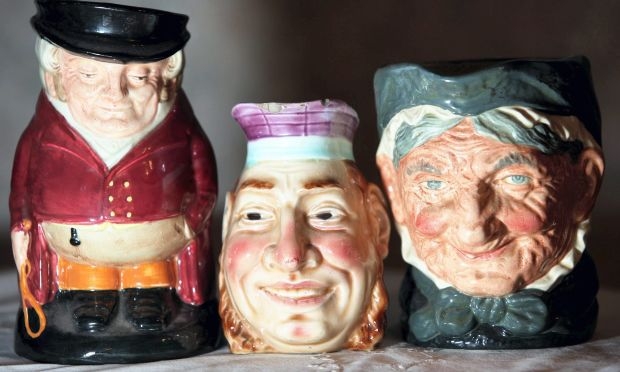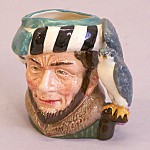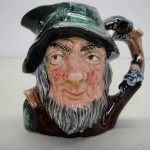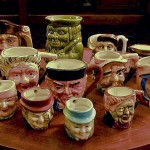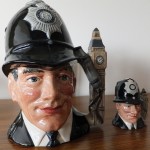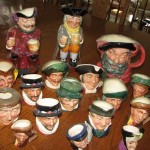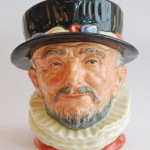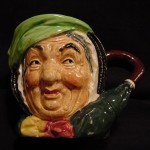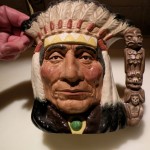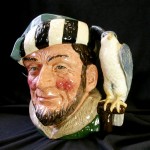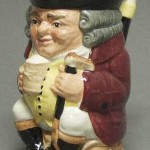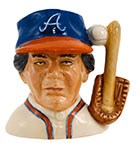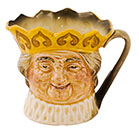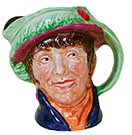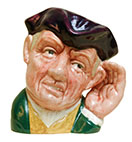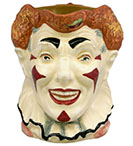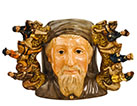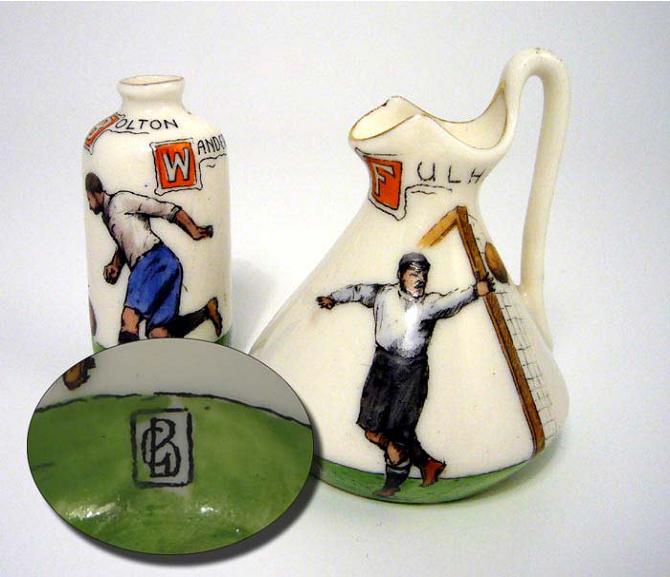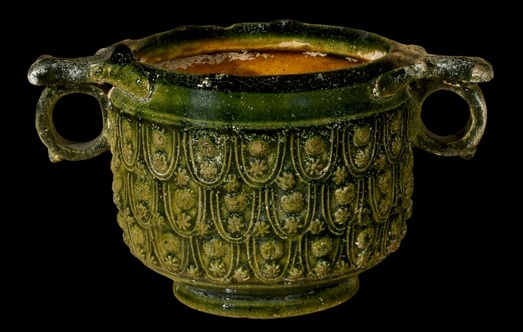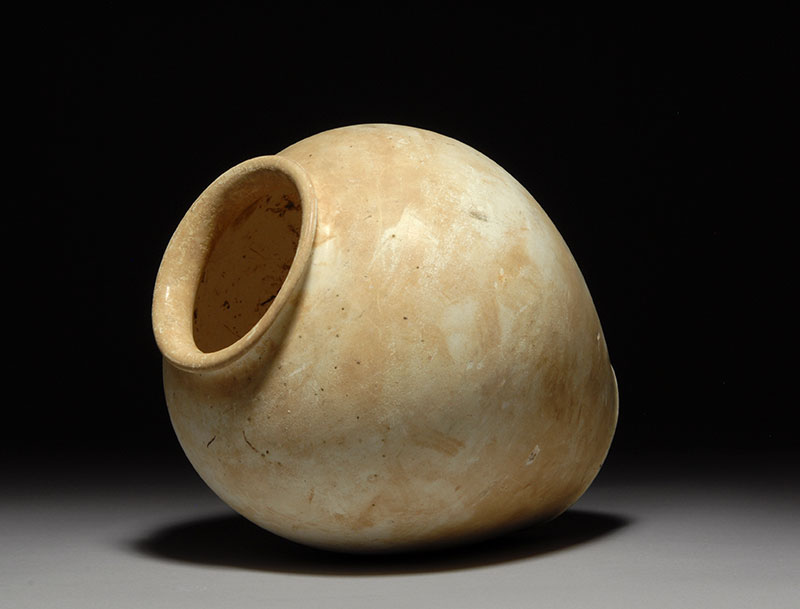Toby jugs and mugs are full bodied figures and are different from character jugs which only show the head and shoulders. A number of toby jugs have music boxes attached to the bottom that play tunes related to the toby jug theme.
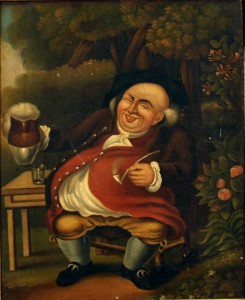 The original toby jug or mug was in the form of a jolly stout man wearing a cocked hat that was named after Toby Fillpot, a drunken character in the song Little Brown Jug that was popular in England and America in the 1700’s.
The original toby jug or mug was in the form of a jolly stout man wearing a cocked hat that was named after Toby Fillpot, a drunken character in the song Little Brown Jug that was popular in England and America in the 1700’s.
A large number of 19th and 20th century toby jugs were modelled after story characters (ie Charles Dickens works) and famous characters of their day such as Winston Churchill. Most toby jug manufactures discontinued producing them, although a few are still being produced.
Some manufacturers issued toby jugs in a series which were popular with collectors. For example Roy Kirkham issued separate Dickens, Robin Hood and the Poorman, Beggarman etc. series of characters.
Toby jugs and mugs were made by Royal Doulton, Beswick, Burleigh Ware, Burlington, Crown Devon, Kevin Francis, Melba Ware, Roy Kirkham, Shaw, Shorter, Sterling, Sylvan, Wood and Sons,Wade and Wedgwood.
A BRIEF HISTORY OF TOBY JUGS
A toby jug is a full-length figure – more often than not male, (although there a few females too) dressed from head to toe in the clothing associated with the 18th Century: That is -a long frock coat, tricorn hat, knee-length breeches, waistcoat and neckerchief. Usually these characters are clutching a jug or drinking vessel, or sometimes a pipe or snuff box.
Toby Jugs have been produced for many years, and although there is some dispute amongst collectors as to their exact origins, it is thought that the first ones were made around the mid 1700’s .
Some collectors believe Toby Jugs are based on the character Toby Filpott who was renowned for his drinking prowess and who is pictured left. There are others who think there could be a connection to the “Low Toby” – similar to a Highway Man, but on foot rather than on horseback (the equivalent of the modern-day mugger!).
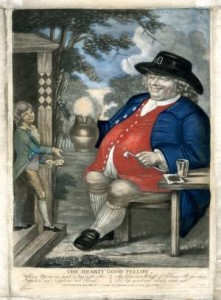 My feeling is that he could be inspired by a number of illustrations of the time – a particular one being the one illustrated right entitled “The Hearty Good Fellow” which is attributed to Francis Hayman (1708-1776). The title of this print is in fact a name used for a Toby Jug, and the print has the following inscription below the image:
My feeling is that he could be inspired by a number of illustrations of the time – a particular one being the one illustrated right entitled “The Hearty Good Fellow” which is attributed to Francis Hayman (1708-1776). The title of this print is in fact a name used for a Toby Jug, and the print has the following inscription below the image:
With my Pipe in one hand, & Jug in the other,
I drink to my Neighbour and Friend;
My Cares in a Whiff of Tobacco I’ll smother, For life you know shortly must end
The Hearty Goodfellow © British Museum
In the engraving below – dating from the early 1800’s,- entitled “A Smoking Club” you can see a group of bawdy looking gentlemen smoking their church warden type pipes.
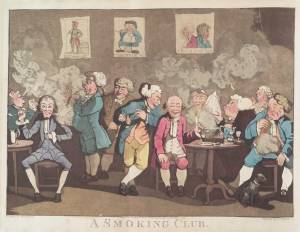 If you look very closely at the table to the righthand side of the picture, you can see a Toby Jug sat upon the table! This suggests that Toby Jugs were in fact a functional item, used in Taverns and Clubs for serving beer.
If you look very closely at the table to the righthand side of the picture, you can see a Toby Jug sat upon the table! This suggests that Toby Jugs were in fact a functional item, used in Taverns and Clubs for serving beer.
Whatever the inspiration, the Toby Jug is generally depicted as a rather rogue-ish character, enjoying the excesses of the time in one way or another! – be it drinking, smoking, taking snuff etc. Often they look a little “worse for wear” with pox marks, missing teeth etc.
The majority of collectors consider the best Toby Jugs were produced during the mid 18th to mid 19th centuries, many of them made with great skill and attention to detail in the modelling and painting. Some of the finest early jugs were produced in the Staffordshire Potteries in England by the likes of Ralph Wood, Whieldon, Walton, Astbury etc, and nowadays it is these jugs which can command very high prices.
From the mid 19th Century onwards, new techniques and mass production methods meant Toby Jugs were being more freely produced and on the whole, these jugs are easier to find today (although as with everything, there are always exceptions). In addition, as potteries have risen and fallen, their jugs have become less available and therefore more collectable.
Please visit The Toby Jug Gallery to some examples of the many different types of Toby Jug.
PLEASE NOTE: Many people confuse Toby Jugs with Character Jugs. A Character Jug is only the head, or head and shoulders, of a figure – more like a cup or mug in shape (see below), and often having an elaborate handle. They are in general much more modern by comparison to a toby and whilst I understand that Character Jugs (in particular those made by Royal Doulton) have a large number of admirers, it is the true Toby Jug that is the one for me and the one to which this site is dedicated.
Collecting Rare Royal Doulton Character and Toby Jugs
Recent sales from the Royal Doulton Archives have released some very rare character jugs into the market, including some prototypes which will be of great interest to collectors. All of them are featured in the new book A Century of Royal Doulton Character and Toby Jugs. Rarities have occurred throughout the history of Doulton jugs due to color and modeling variations and limited production periods. Even comparatively recent designs become rare when the edition size does not meet collector demand.
This miniature size Baseball Player in the colors of the Atlanta Braves was piloted in 1996 but never put into production.
This miniature size Trapper was piloted but was never put into production. The block was recorded in storage at the Nile Street factory in 1980. A handful of examples are known in private collections.
Early versions of Old King Cole were decorated with a yellow crown and gray hair. This was soon changed to a brown crown with red hair. Because of the limited production of the ‘Yellow Crown’ version it is now very rare.
Fenton’s first model for ‘Arry, the Cockney character, featured pearl buttons embossed in the design and is now known to collectors as ‘Pearly Boy’. The buttons were removed to save costs in the post-war economic climate. Undecorated white jugs were produced by Doulton during World War II and its aftermath. The clay models have slight production flaws so it was not worth painting them for export. Instead they were glazed for limited distribution and are now considered very desirable.
Fenton’s first model for ‘Arriet was decorated in different colors, most noticeably a lime green hat feather. This color version is known to collectors as the Pearly Girl and is considered very rare.
This character jug was only made for three years so production was very limited and it is now a very valuable jug.
The Clown was originally decorated with brown hair but some much rarer red-haired versions exist with brighter face paint, including black eyebrows. After World War II, the decoration was completely changed and the clown has white hair.
This is the largest and most complex character jug ever produced by Doulton. It was limited to just 1,500 world-wide and sold out very quickly so it is hard to find today.
A Century of Royal Doulton Character and Toby Jugs
Visit: http://www.tobyjugmuseum.com/
Credit:
http://www.tobyjug.collecting.org.uk/
http://doultonpriceguide.com/

